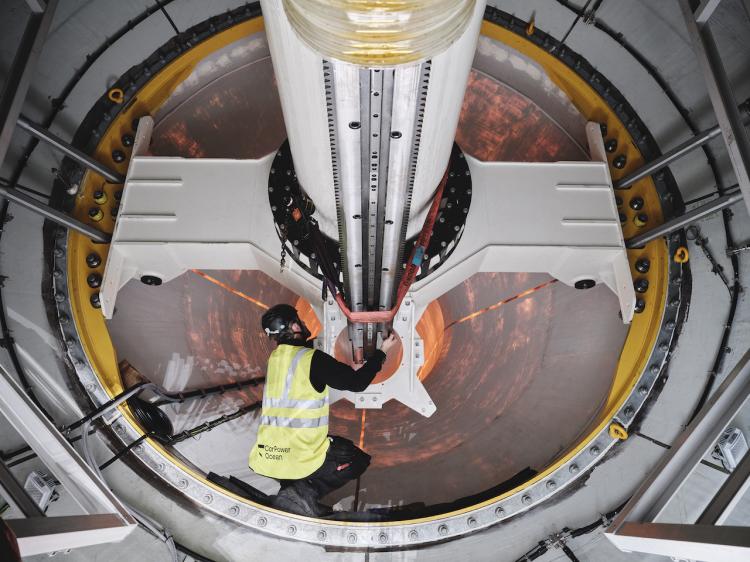Highlights
- CorPower Ocean's first commercial scale wave energy device, C4, nears completion of planned on-land inspection and upgrades, following first cycle of successful ocean commissioning
- Upgrades applied to system capacity based on first 2000h of operational data
- Preparations begin for redeployment and continued operations to verify upgrades including increased peak power capacity and advance control methods
CorPower Ocean is completing post-deployment inspections and a series of planned on-land upgrades, addressing key findings from operational data collected during the successful ocean deployment phase of its commercial scale C4 WEC (Wave Energy Converter).

It follows the disconnection and retrieval of the C4 device after completing its first cycle of ocean commissioning in Aguçadoura, northern Portugal.
In recent months engineers have performed careful inspections, adjustments and upgrades to finetune the system based on the data. Upgrades have been designed to address lessons learned, and systematically improve subsystems to increase operational range, power capacity and reliability.
It comes after post-deployment inspections provided numerous insights in areas including biofouling, corrosion, robustness and station keeping in storm conditions (*see footnotes).

Electrical data collected during operation has further informed upgrades to increase the system's peak power capacity from the confirmed 600kW, towards 850kW, by adding further capacitance to the DC-link of the electrical drivetrain and upgrading new inverters with higher voltage rating.
In addition, sensor upgrades and calibrations have been applied to boost accuracy of measuring and predicting device motion in six degrees of freedom. Furthermore, the tidal regulator located under the C4 has been upgraded with a new grease system and improved seal / scraper solution to deliver long-term, reliable operation and protection from fouling, while upgrading drive electronics to allow equal speed of retraction and extension under load.
Moving forward, the C4 will be redeployed in Aguçadoura, before engaging in a new operational phase to demonstrate full power capacity including further advancement in control methods. When commissioning is complete, a Power Performance Assessment phase will begin in accordance with IEC/TS 62600-100 standards.
CorPower Director of Integration & Testing Jean-Michel Chauvet said: "Since the initial C4 deployment in August 2023, all key aspects of the C4 system functions have now been successfully verified including power export to grid, automated control and monitoring of the system as well as safe Operations and Maintenance (O&M) methods. We are nearing completion of this latest round of upgrades involving both mechanical components and software based on the first cycle of learnings made based on 2000h of data, in order to further increase power output and operational range when the device is redeployed in Aguçadoura."
The O&M cycle was carried out at CorPower Ocean's dedicated on-land base in Viana do Castelo.
Now proven at commercial scale, at the exposed Atlantic test site, the C4 device has already demonstrated unique ability to tune and detune according to varying sea states, limiting response to extreme storm waves (up to 18.5m) while amplifying motion and power capture in regular waves using novel phase control technology.
The progression marks a crucial milestone for wave energy addressing the two major obstacles which have hampered commercial adoption to date - survivability and efficient power generation in normal ocean conditions.
"We are pleased with progress made to date and look forward to the concretisation of our goals for the C4 following recent upgrades," added Mr Chauvet: "It's an important phase as we move towards Stage 5 of the HiWave and EU-SCORES Demonstration Project involving a CorPack wave cluster with three additional C5 devices. We are rapidly advancing in our mission to deliver a robust and efficient turnkey solution that allows our customers to generate electricity from ocean waves."
Further details on results from the first phase of C4 operations can be found>>> here. A Press Kit with further information/ high-resolution images/ videos can be found >>here. For further information on CorPower Ocean visit www.corpowerocean.com or email ida.malmborg@corpoweroocean.com.
*Footnotes
Further insights from post deployment inspections:
- Corrosion: inspections confirmed that chosen corrosion protection solutions have generally worked satisfactory. The composite hull making up most of the surface in contact with sea water was inherently corrosion protected by the material stack. The four metal rods in contact with sea water at the bottom with laser cladded surface coating have shown excellent corrosion resistance. A few parts around seal gland assemblies that relied on cathodic protection were found corroded, which was addressed by adding appropriate electrical connection to the cathodic protection. A few parts of the H-link connecting the bottom of the tidal regulator with the anchor quick connector had a paint-based protection systems that was found inadequate, with root cause found to be quality issue in the coating process that were addressed.
- Biofouling: The anti-fouling protection solutions have been found to work satisfactory on both hull and ocean rods. The commercially available anti-fouling paints used were found to supress biofouling. Alloy-Coated rods at the bottom rely on periodic scraping sequence performed by the machine control system. Upgrades to the seal gland and scraper of the tidal regulator have been performed in collaboration with the supplier, aimed at ensuring long term reliability of the scraping function.
- Robustness in storm waves: While the other floating installations on the Agucadoura site, including marker buoys and wave measurement buoys, have been periodically lost in extreme waves (measured up to 18.5m), the C4 WEC was confirmed to ride through the fiercest conditions in its storm survival mode with minimum excitation and robust station keeping. Post deployment inspection of the UMACK anchor could not detect any measurable creep of the anchor. The camera and antenna assembly on the top of the device were found to have inadequate robustness when swept by storm waves, which was upgraded with an improved design. A key learning is that any protruding part from the spheric hull can become a weak spot when large waves slam the otherwise robust surfaces of the system, and upgrades to the external ladder and access platform have been performed to ensure further robustness in the conditions.









